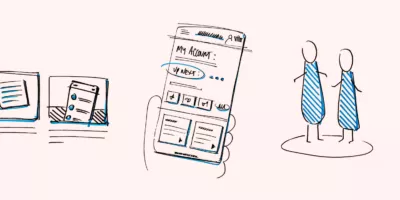09 Nov 2023
5 ways to create impact through prototyping

At cxpartners prototyping is more than an essential tool in our toolbox; it’s a mindset we apply to all of our projects.
It helps us create an environment that’s focused on learning and using evidence to inform and validate decisions, so that we can collectively make the best decisions possible.
There are lots of different tips and tricks out there for creating effective prototypes, but this article is slightly different. This is about how you can generate excitement about prototyping in your organisation that simply can’t be ignored.
-
Sam Stevens
Principal UX Consultant

1. Find the right format!
What is the first thing that you think of when you think “prototype”?
You may think of a digital clickable prototype, a series of iterative prototypes hacked together with bits of card or maybe a rough sketch of the back of a napkin! And yes, you are right these are all prototypes – they come in lots of different shapes and sizes.
The important thing when starting out is to remember that – at its core – a prototype is about learning. It’s about finding small ways to test big things, and the format of your prototype plays a big part in this.
When deciding on the best format it is critical to be really clear on what you hope to learn from your prototype and to be intentional about this. Here are some questions that we ask ourselves to help us identify just that:
- Why are we creating a prototype?
- Who is the prototype for?
- What is the idea or hypothesis that we are testing?
- What is the context that the prototype will be used in?
- How will we share the prototype with users?
- What do we have around us that we could use to help create the prototype?

2. Set the scene
This may sound obvious, but so many times we see teams jumping straight into the detail when sharing their prototype with the wider team before setting the scene.
Providing the context of the problem you are trying to solve, the opportunity you have spotted or recapping the needs of the users that you’re designing for is critical before jumping into the details that you are inevitably eager to show.
When we run through a prototype with project stakeholders, we also do our best to figure out what is important to them. We’ve learnt that this is often different to what we initially imagined, andt it’s essential to get it just right if we’re going to create impact.
So, when preparing to walk project stakeholders through a prototype, we will have these questions in mind:
- Do our stakeholders have a clear grasp of the opportunity or the problem to solve?
- Are they driven to help make enhancements in the customer experience?
- Are they tasked with making operational or financial efficiencies?
- What kind of questions might they have about technical feasibility?
- Are they used to critiquing prototypes and working out in the open in this way?
- What will get their attention and keep them interested throughout?
- How will this prototype help to improve the performance of the organisation?
3. Make it visible!
Within organisations there can be a lot of noise that you need to find a way to cut through. That’s why it is so important to make sure that the work you are doing is visible to the right people – at the right time – to give it the best chance of making an impact and creating excitement!
At cxpartners we have a general principle that we don’t do big “ta-da!” moments. Instead, we work in the open to share our work and collaborate at all times to make sure all voices are heard. This approach also helps ensure that we don’t stumble upon a nasty surprise late on in a project!
We’ve found that sharing, and increasing visibility of prototyping work can be done effectively in a number of ways:
- Not be be afraid of sharing your thoughts and progress early on.
- Find effectives ways to share the prototype. For example; run a Show & Tell with a wider group or use tools like Loom to keep time-poor stakeholders in the loop.
- Invite people into the process by sharing your Miro board or Figma file so they can take a look and add comments in their own time.
- Position it as an informal “lunch & learn” session where people can attend and contribute.
4. Involve the people you are designing for
At cxpartners user centred design is our thing, and involving the people we are designing for throughout the design process is one of our go-to super powers.
This practice enables an evidence-based approach, which removes subjectivity from decision making and helps ensure we create the right thing.
When we are prototyping this works in two ways:
- We include a thorough representation of the people that we are designing for. This means we can increase our confidence that what we prototype really aligns with their needs and expectations. It’s even better if we can work alongside these people to create the prototype together.
- We will also make sure that we have representation from across the organisation. This means we’ll hear from a range of different voices, and that those within the organisation who are responsible for the product or service we are working are represented and have played a part in the prototype’s creation.
Why are these two things important? Essentially, it helps us to reduce risk and increase confidence in the direction that we are heading and the decisions that need to be made.
How can you involve the people impacted by your prototype in the process?
- Start by identifying who will be impacted by your prototype.
- Create space in the project plan to involve these people throughout the process.
- Demonstrate the value back to the organisation having involved these people.
5. Share the learnings – the good, the bad, and the ugly
As I explained earlier, the prototyping work that we do at cxpartners is about learning and experimentation, and with any level of experimentation there are always unexpected results! Perhaps the prototype has…
- Resulted in creating some kind of completely unintended consequence that you hadn’t even considered before.
- Didn’t quite resonate or meet the needs of the users as you may have expected it too, and has identified another opportunity or gap to address.
- Helped you uncover something completely different, resulting in you being able to make a quick fix to your live service.
All of these would be brilliant learnings! And so important that you have learnt about them whilst prototyping, not as you’re launching your new service into the world.
It means it has been worth investing (what may have been considered) additional time upfront. It means you are now on the front foot and can take action to respond to these learnings – so that your live product or service can deliver the intended impact.
Lastly, make sure that you share your learnings big or small so that others can benefit from it understand the power of using a prototyping mindset to their own work.
Find out more
At cxpartners prototyping is a core to all of our work. I’d love to talk with you about how we can help you to take a prototyping mindset to problem solving and exploring big opportunities.
I’ll also be speaking about this in more detail at our upcoming webinar ‘Prototyping to deliver more value, sooner’ so please do come along to find out more!
You can sign up here.



